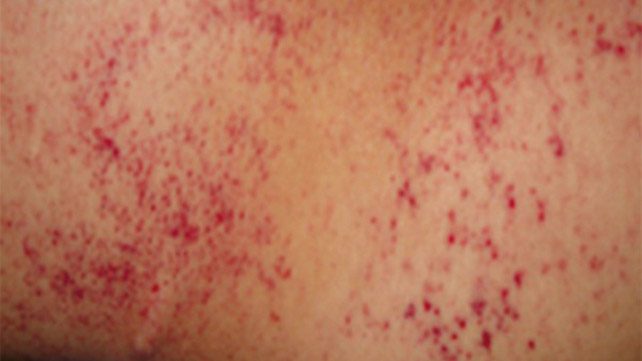Contents
Petechiae: definition, symptoms and treatments
Small red spots on the skin, petechiae are the symptom of several pathologies whose diagnosis must be specified before any treatment. They have the particularity of appearing in the form of small red dots grouped together in plaques which do not disappear with vitropression. Explanations.
What is a petechiae?
Small bright red or purplish dots, most often grouped in plaques, petechiae are differentiated from other small spots on the skin by the fact that they do not disappear when pressed (vitropression, pressure exerted on the skin to using a small transparent glass slide).
Their individual diameter does not exceed 2 mm and their extent is sometimes considerable over several regions of the skin:
- calves;
- arm ;
- torso;
- face ;
- etc.
They are most often sudden onset, associated with other symptoms (fever, cough, headache, etc.) which will guide the diagnosis of the cause of their occurrence. They can also be present on the mucous membranes such as:
- the mouth ;
- language ;
- or the whites of the eyes (conjunctiva) which is a worrying symptom that may indicate a severe disorder of blood platelet clotting.
When the diameter of these points is larger, we speak of purpura. Petechiae and purpura correspond to the presence under the skin of hemorrhagic lesions in the form of small dots or larger plaques, formed by the passage of red blood cells through the walls of capillaries (very fine vessels present under the skin), such as a small hematoma.
What are the causes of petechiae?
The causes at the origin of the occurrence of petechiae are multiple, we find there:
- diseases of the blood and white blood cells such as leukemia;
- lymphoma which is cancer of the lymph nodes;
- a problem with blood platelets which are involved in clotting;
- vasculitis which is inflammation of the vessels;
- thrombocytopenic purpura which is an autoimmune disease causing a significant drop in the level of platelets in the blood;
- certain viral diseases such as influenza, dengue fever, sometimes meningitis in children which can be very severe;
- the Covid-19;
- side effects of chemotherapy;
- intense vomiting during gastroenteritis;
- certain medications like aspirin;
- anti-coagulants, antidepressants, antibiotics, etc. ;
- certain small skin traumas (at the level of the skin) such as bruises or the wearing of compression stockings.
Most petechiae testify to benign and transient pathologies. They regress spontaneously in a few days, without after-effects, except for brown spots which eventually fade over time. But in other cases, they testify to a more severe pathology such as fulgurans pneumococcal meningitis in children, which then constitutes a vital emergency.
How to treat the presence of petechiae on the skin?
Petechiae are not a disease but a symptom. Their discovery during the clinical examination requires specifying the disease in question by questioning, the other symptoms present (in particular fever), the results of additional examinations, etc.
Depending on the diagnosis made, the treatment will be that of the cause:
- discontinuation of the drugs involved;
- corticosteroid therapy for autoimmune diseases;
- chemotherapy for cancers of the blood and lymph nodes;
- antibiotic therapy in case of infection;
- etc.
Only petechiae of traumatic origin will be treated locally by applying cold compresses or an ointment based on arnica. After scratching, it is necessary to disinfect locally and to dab with compresses.
The prognosis is most often that of the disease in question except for petechiae of traumatic origin which will quickly disappear.











may sakit akong petechiae, maaari paba akong mabuhay?